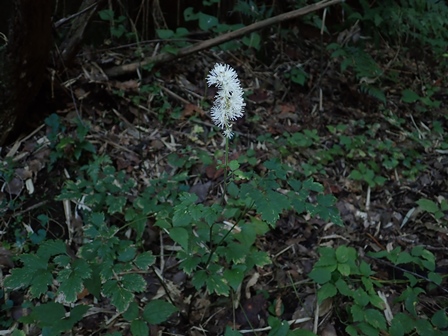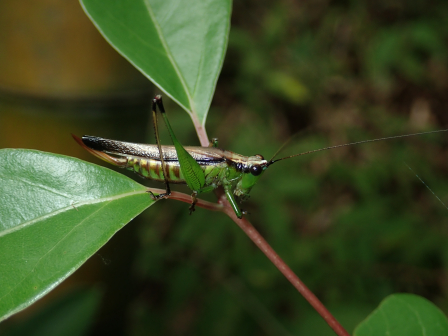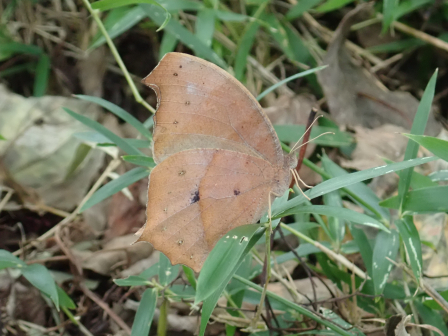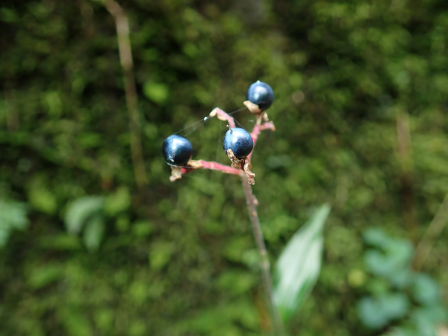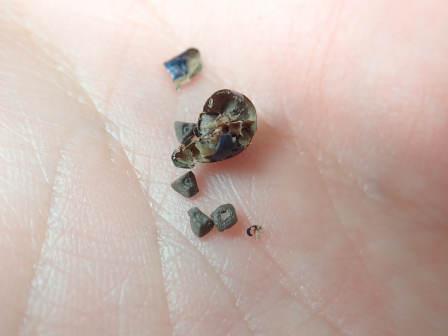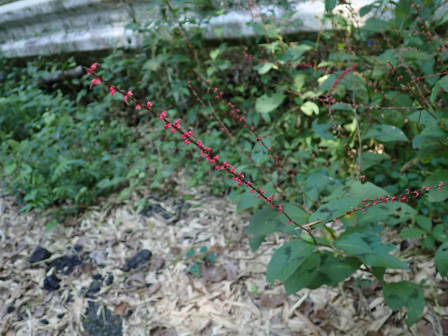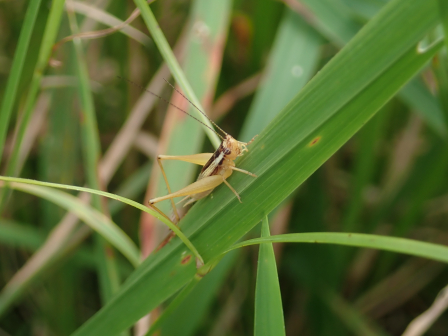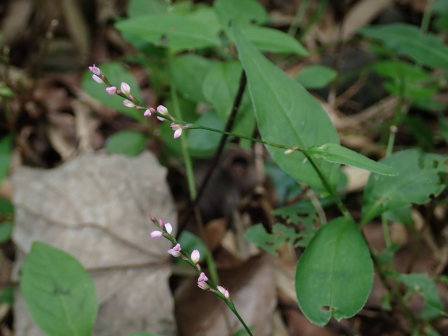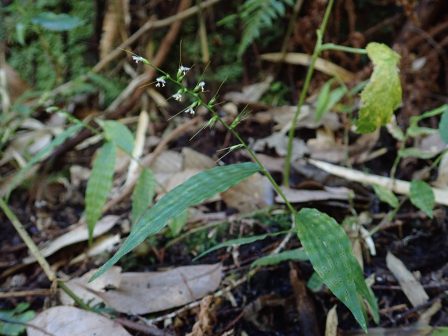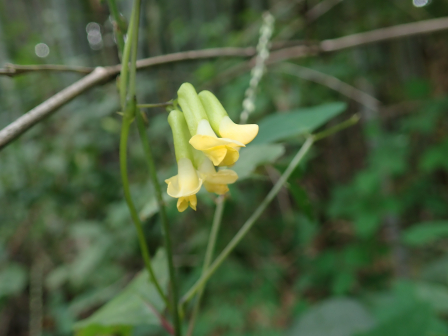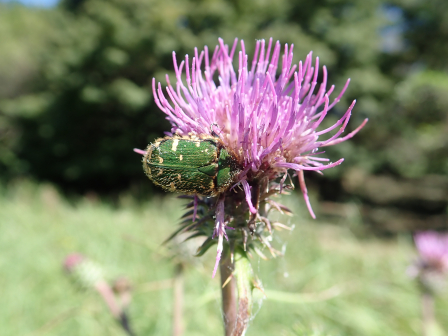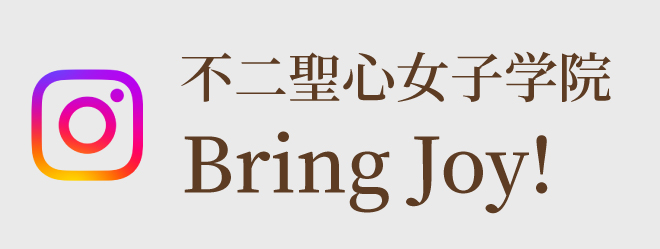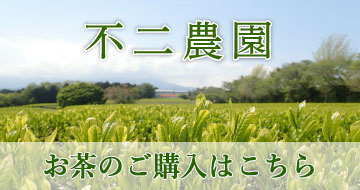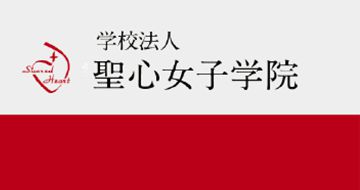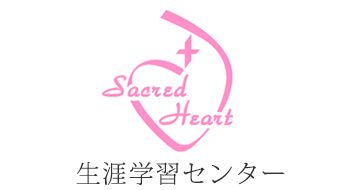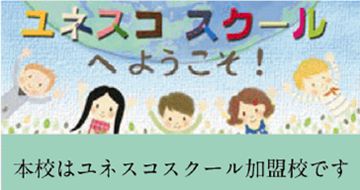フィールド日記
2021.11.02
サラシナショウマ
裏道でサラシナショウマが咲いていました。和名のサラシナとは晒し菜の意味で、本種の若芽を食用とするときに、水で晒してから食べることに由来します。また、本種の根は漢方薬の升麻(ショウマ)として市販されることもあります。
"Sarashina-Shouma (サラシナショウマ)" plants are in bloom on the back road. "Sarashina (サラシナ)" in its name means "rinsed vegetables" and comes from the fact that people rinse the plants in water to remove the harsh taste before eating. The roots of this plant are sold as a herbal medicine called "Shouma (ショウマ)".
2021.10.29
ササキリ
共生の森のまわりでササキリを見つけました。ホシササキリやオナガササキリなど明るい環境を好む他のササキリのなかまに比べ、林縁など薄暗い環境でよく見られます。名前の通り、ササ類を好みます。
I found a "Sasa-Kiri (ササキリ)" cricket around the Kyoseinomori-Forest (共生の森). Compared to other crickets in the same group such as "Hoshi-Sasakiri (ホシササキリ)" and "Onaga-sasakiri (オナガササキリ)" crickets, which prefer bright enviroments, they are more often seen in dark environments such as forest edges. "Sasa (ササ)" in its name means "Sasa" plants and "Sasa-Kiri" literally prefer eating Sasa plants.
2021.10.26
クロコノマチョウ
共生の森でクロコノマチョウを見つけました。林床の低い位置を飛び、地面にもよくとまります。翅の裏面は枯れ葉のような模様で、あまり目立ちません。もともと南方系の蝶ですが、近年分布を北に広げています。
I found a butterfly called "Kuro-Konomachou (クロコノマチョウ)" in the Kyoseinomori-Forest (共生の森). They fly low over woodland floors and are often seen on the ground. The pattern on the backside of their wings look like dead leaves so they are well camouflaged. They originally live in southern area of Japan but now they are spreading toward the north.
2021.10.22
ヤブミョウガ
裏道でヤブミョウガの果実がなっていました。果実は光沢のある藍色ですが、この色はコガネムシの体などと同様に、構造色と呼ばれ、果皮の物理的な形状によって見えている色だといわれています。
見た目はブルーベリーのようですが、中は乾燥していて、小石のような種子が入っています。
(ヤブミョウガの花のようすはこちら)
2021.10.19
ミズヒキ
裏道でミズヒキが見られます。林縁などでよく見られるタデ科の植物です。和名は、赤い花が長い穂状につくようすを、祝儀袋などにかける飾り紐の水引に見立てたことに由来します。
白花の品種をギンミズヒキと呼びます。裏道でもときどき見られます。
I found "Mizuhiki (ミズヒキ)" plants on the back road. They are a plant that belongs to the "Knotweed" group and is often seen in forest edges. The name comes from their flowers that look like Japanese traditional ribbons called "Mizuhiki (水引)" to wrap gifts.
Their white-flower variety is called "Gin-Mizuhiki (ギンミズヒキ)". They are sometimes seen on the back road, too.
2021.10.15
カヤコオロギ
ファーストオークヒルでカヤコオロギが見られます。体長は1㎝ほどで、チガヤなどが生える明るい草地に生息しています。近年、草地の減少とともに、数が減っていると言われています。コオロギの一種ですが、翅は短く、鳴くことはできません。
I found crickets called "Kaya-Koorogi (カヤコオロギ)" in the First Oak Hill. They are about 4 cm in body length and live in sunny grasslands. In these years, as grasslands are decreasing, "Kaya-Koorogi" crickets are also reducing in their number. They are a kind of crickets, which are well known as a singing insect group, but they have short wings and cannot sing.
2021.10.12
ハナタデ
裏道にハナタデが咲いています。名前にタデとつく似た仲間が多くありますが、比較的花の数が少ない本種に花タデという名がついています。牧野富太郎博士によると、本種をハナタデと呼ぶのは間違いで、今日イヌタデと呼ばれている種が本来のハナタデであるそうです。
"Hana-Tade (ハナタデ)" plants are in bloom on the back road. There are many relative species whose names include "Tade (タデ)". However, among those species, this species has less flowers although "Hana (ハナ)" in its name means "flower". According to Dr. Makino, it is wrong to call this species "Hata-Tade" and another species called "Inu-Tade (イヌタデ)" should be called "Hata-Tade".
2021.10.08
チヂミザサ
裏道でチヂミザサが咲いていました。林中や林縁など、日陰によく見られます。和名はしわの多い、ササのような葉をもつことに由来します。葉などに基部のふくれた長毛が生えているものをケチヂミザサ、生えていないものをコチジミザサと2変種に分けることもあります。
"Chijimi-Zasa (チヂミザサ)" plants are in bloom on the back road. They are often seen in the shade such as on forest edges and in forests. The name comes from their wrinkled leaves resembling Sasa plant's leaves. "Chijimi-Zasa (チヂミザサ)" can be divided into two varieties. One, which has long hair with swollen bottom, is called "Ke-Chijimi-Zasa (ケチヂミザサ)". The other, which doesn't have hair, is called "Ko-Chijimi-Zasa (コチジミザサ)".
2021.10.05
ノササゲ
裏道でノササゲの花が咲いていました。街中ではあまり見かけませんが、林縁などではよく見られます。和名は野に見られるササゲという意味ですが、食用にはされないようです。
"No-Sasage (ノササゲ)" plants are in bloom on the back road. They are not often seen in the city but are often seen in forest edges. Their name comes from edible beans called "Sasage (ササゲ)" but this species is not edible.
2021.10.01
コアオハナムグリ
アザミの花にコアオハナムグリが来ていました。春から秋にかけてみられ、個体数も多い普通種です。主に花の蜜や花粉を食べています。背中全体に毛が生えていることが特徴です。
I found a beetle called "Ko-Ao-Hanamuguri (コアオハナムグリ)" on a thistle flower. They are a common species that can be seen from spring to fall. They eat nectar and pollens of flowers. They have hair on their entire backs.


